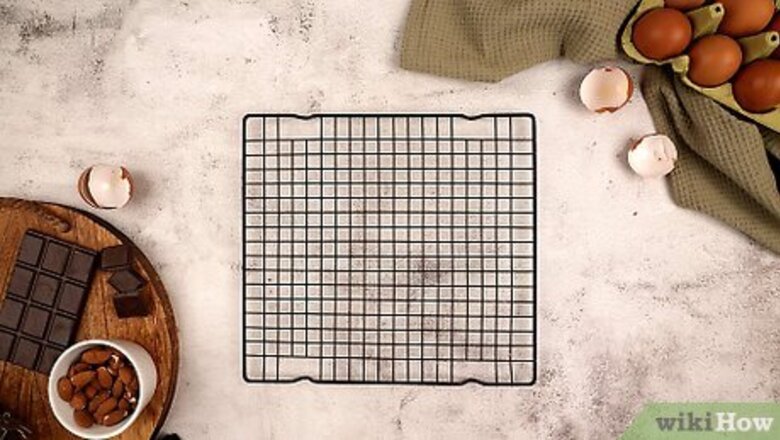
views
Cooling a Cake on a Cooling Rack
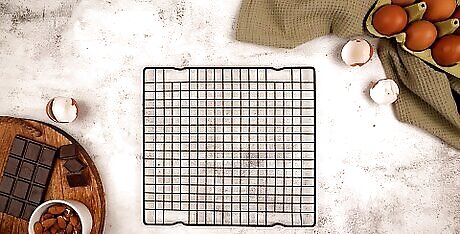
Choose the right cooling rack. Make sure to pick your cooling rack according to the size of the cake you are baking. 10-inches seems to be the largest standard pan size (for bundt cakes and round cakes), so a rack that is at least 10-inches across should serve just about all of your needs. Cooling racks are an essential tool for any baker as they help your cake cool evenly and quickly. Here are a few things to consider: Pick a wire rack that is easy to fit in your dishwasher and in the area you plan to store it. Cooling racks work by allowing air to circulate under your cake, which helps prevent condensation which could make the bottom soggy.
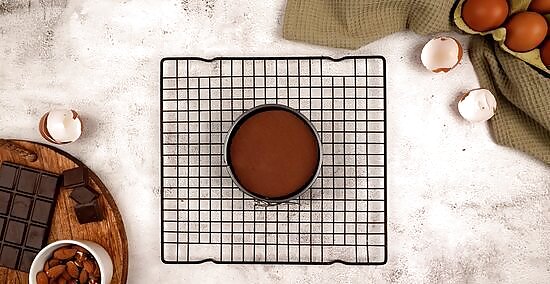
Remove your cake from the oven. Once your cake is fully cooked, use oven mitts to carefully take it out of the oven and place the pan directly on your cooling rack. If you are cooling a cheesecake, you can simply turn off the oven and leave your cake inside to cool for about an hour. This allows the delicate cake to cool slowly, which will help prevent it from cracking.
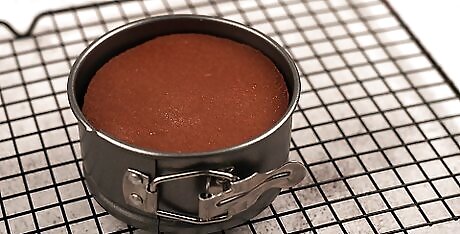
Let your cake sit. At this point, it is a good idea to check your cooking instructions for cooling time guidelines. Cooling time can vary considerably depending on the type of cake you are baking. As a rule of thumb, expect to cool your cake on the rack for 10-15 minutes. The cake pan should be resting on the rack to ensure that the bottom of the cake pan has airflow.
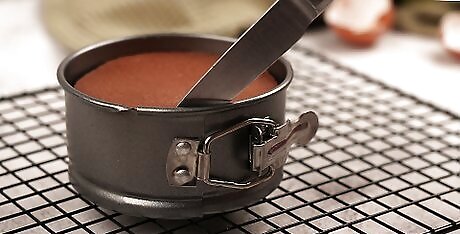
Loosen your cake from the pan. Remove your cake pan from the cooling rack and place it on the counter. Use a sharp knife or butter knife and run it along the edges of the pan between the rim of the pan and the cake. Be sure to keep your knife vertical so you don't accidentally cut into the sides of your cake. Run the knife around the edges a couple times to loosen your cake from the pan.

Spray your cooling rack. Before transferring your cake directly to the cooling rack, you will need to lightly spray your rack with cooking spray. Since your cake will still be slightly warm, placing it on a rack with cooking spray will prevent it from sticking to the wire rack.
Transfer your cake directly to the rack (optional). Hold the cooling rack over the top of the pan and slowly turn the pan upside down. Gently tap the bottom of the pan until the cake releases. Slowly lift the pan away to transfer your cake to the cooling rack. Before removing your cake from the pan, consider this: If you are cooling a cheesecake, you won't want to attempt to transfer your cake to the wire rack. Cheesecakes are very delicate and this could ruin your cake. If you are cooling a pound cake, removing your cake from the pan sooner will help keep it from getting too soggy. If you are cooling an angel food cake, you may want to skip the wire rack and place it upside down on the counter instead. To cool your cake upside down, turn the pan upside down and set the tube part over the neck of a stable bottle. Turning it upside down for cooling helps prevent it from collapsing as it cools. Remember to use oven mitts when handling the pan. Since the pan hasn't been out of the oven for very long, it may still be hot enough to burn you.

Remove your cake from the cooling rack. After letting your cake fully cool for 1-2 hours, you can transfer it to a plate or platter and frost and decorate however you wish.
Cooling a Cake in the Refrigerator

Decide how much time you have. Depending on the type of cake, cooling using this method can be done in just a couple of hours. Here are some things to consider: Angel food cakes, pound cakes, sponge cakes and other light and fluffy cakes can cool in the refrigerator in about 1-2 hours. This method may not be the best choice for a cheesecake, as quick changes of temperature can upset the structure of the cake, causing cracks. For rich, creamy cakes that are served chilled, this method may take you up to 4 hours. If you are cooling a traditional cake, this method will take you about 2-3 hours.

Remove your cake from the oven. Once your cake is fully cooked, use oven mitts to carefully take it out of the oven and place it on the kitchen counter. Let your cake sit for 5-10 minutes. Here are some guidelines to consider: If you are working with a cheesecake, or other creamy cake, it is recommended that you turn off the heat and let your cake cool in the oven for about an hour before transferring your cake to the refrigerator. If you don't have the time, you can put your cake in the refrigerator although it may crack slightly. If you are working with cheesecake, run a butter knife along the edge of the cake and the pan while the cake is still warm, this will prevent the cake from sticking to the pan later. You may want to place your cake pan on a wooden surface like a cutting board to protect your countertop from heat damage.
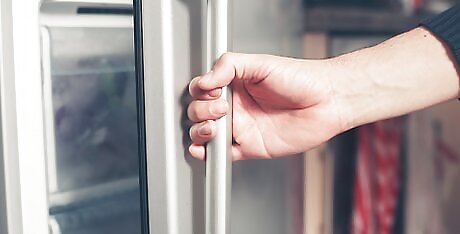
Put your cake in the fridge. After allowing it to cool briefly on the countertop, place your cake pan in the refrigerator for another 5-10 minutes. This will further cool the cake without causing it to dry out. It should be pretty cool to the touch after 5 or 10 minutes. Here are some things to consider: If you are cooling a sponge or angel food cake, it is recommended that you cool the cake upside down. This can be done by turning the pan upside down and setting the tube part over the neck of a stable bottle. Turning it upside down for cooling helps prevent it from collapsing as it cools. If you are cooling a pound cake, it is recommended that you take it out of the pan to cool it. Cooling a pound cake for too long in a pan can cause it to become overly damp and stick to the pan. Transfer it to a wire rack and place it in the refrigerator.

Wrap your cake in plastic wrap. Take your cake pan back out of the fridge and seal the top of your cake pan by wrapping it at least twice over with plastic wrap. Sealing the cake tight will help keep it moist as it continues to cool. If you have removed your cake from the pan or placed it upside down, you don't need to wrap it up.
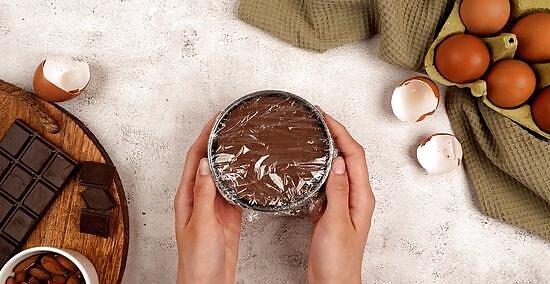
Let your cake cool in the refrigerator for an additional 1-2 hours. If you are chilling an angel food cake or pound cake, you may only need to cool it for an additional hour. If you are cooling a cheesecake, let it cool for the entire 2 hours.

Loosen your cake from the pan. Use a sharp knife or butter knife and run it along the edges of the pan between the rim of the pan and the cake. Be sure to keep your knife vertical so you don't accidentally cut into the sides of your cake.

Remove your cake from the pan. Place a large plate over the cake pan. Hold the plate and the pan firmly together and flip them upside down. Shake the pan softly to transfer your cake from pan to platter. If your cake is especially delicate, gently tap the bottom of the pan a few times until you feel your cake release. Now that your cake is cool, you are free to frost and decorate however you wish!













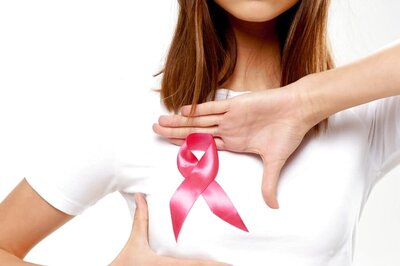


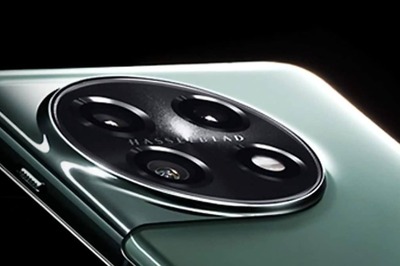
Comments
0 comment